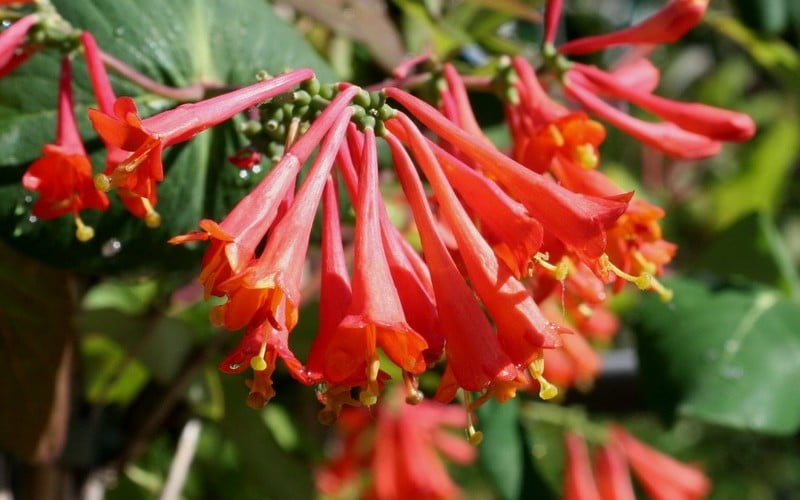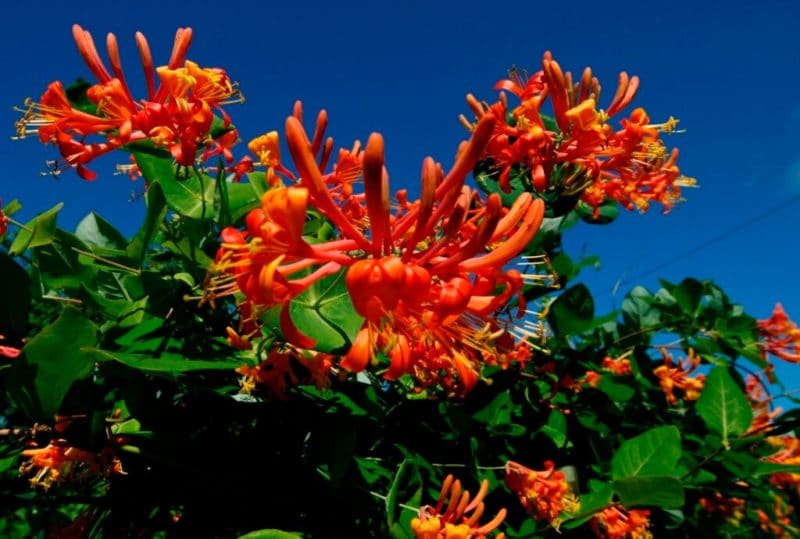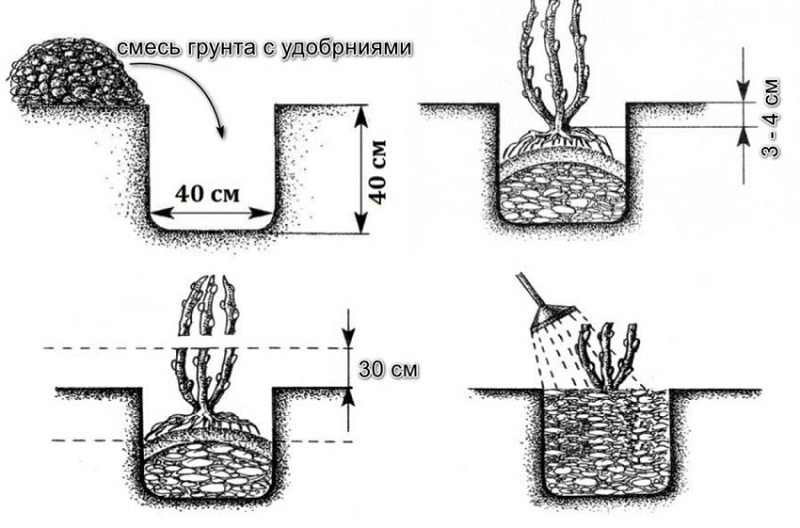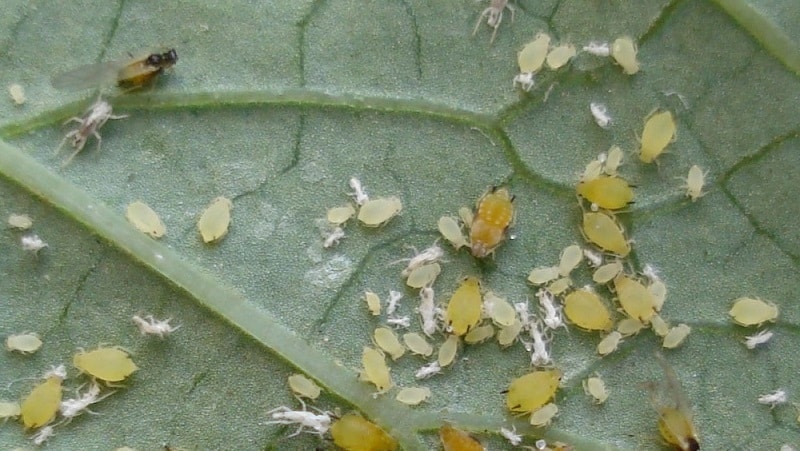Brown's fuchsia honeysuckle is a bright decorative variety
Decorative honeysuckle is a plant well known to amateur gardeners. There are many types of it, but Brown's honeysuckle and its varieties are especially popular. The plant is very beautiful and easy to care for. Curly shoots with thick, lush greenery and bright corollas of flowers will perfectly decorate an old fence, weave around a decorative support, or spread a fluffy carpet on a rocky part of the garden that is not suitable for other plants. Today we will talk about a variety of Brown's honeysuckle - fuchsia.
Brown's honeysuckle: variety description
Brown's fuchsia honeysuckle is a vine-like climbing shrub with glossy, rounded leaves and fan-shaped corollas of purplish-red flowers. They resemble fuchsia in color and shape.
The bush blooms in early June, and sometimes in May, and pleases the eye until late autumn. Honeysuckle is very decorative. The foliage remains lush green throughout the season. The decoration includes both lush colorful flower corollas and bright red fruits.

Breeding history
Brown's honeysuckle (Lonicera brownii) was bred by crossing 2 North American varieties: evergreen honeysuckle (L. sempervirens) and rough honeysuckle (L. hirsuta).
From the evergreen variety, the variety received a strong trunk and bright inflorescences; from the rough variety, flexible climbing vines and bright greenery. Various varieties of this plant are widely used in ornamental gardening.
Characteristics and description of appearance
Let's take a closer look at the external characteristics:
- The variety belongs to the category of semi-evergreen shrubs, which, during relatively warm winters, retain their foliage and thereby greatly decorate the garden.
- The plant is prone to remontancy: it is capable of repeatedly blooming and bearing fruit until late autumn.
- The liana grows more than 2 m. The shoots are flexible, first green and then brownish-purple.
- The leaves are dense, oval, with a rounded end. Glossy, dark green above, matte, bluish below. On the stem they are planted opposite each other on short petioles. At the end of the shoot, 2 leaves grow together into a solid rounded corolla, which greatly decorates the shoot.
- The roots are powerful, branched, tree-like. During winter thaws, when trying to flower, there is a danger of the roots drying out due to lack of moisture in the frozen ground.
- Flowers are in the shape of an elongated thin bell up to 5 cm long, collected in fan-shaped inflorescences from 5 to 30 pieces. The color on the outside is pink-red, on the inside - from yellow-orange to bright red. The pistil and bright yellow stamens protrude slightly and create a delicate halo around the flower. The aroma is very weak or absent.
- The berries are bright red, glossy, very beautiful. Inedible.
- The seeds are black, 2-3 mm in diameter. They ripen at the end of November and are used for breeding new varieties.
Features of application
Fuchsia honeysuckle – exclusively decorative variety. It is categorically unsuitable for consumption and is poisonous, but is indispensable in landscape design:
- It entwines any supports: fences, fences, gratings, columns.
- It can be used to successfully decorate the wall of a house or any object in the garden that cannot be removed.
- With the help of Brown's honeysuckle, you can create decorative colorful ensembles on city streets, especially where it is not possible to plant trees. Bright red-orange buds are noticeable from afar and serve as a living decoration.
- Honeysuckle spreads along the ground and acts as a living carpet on lawns and parks, hiding uneven landscapes and preventing the growth of weeds.
- It grows up to 2 m in height, which makes it possible to use it as hedges to delimit the territory into zones or protect against curious neighbors.
- The liana is suitable for decorating gazebos and pergolas (decorative canopies), as well as various outbuildings.
- Trellis (2 posts with a lattice or mesh between them), braided with honeysuckle, will be a wonderful decoration in any place in the park or garden.
Flowering period
Fuchsia honeysuckle blooms for a very long time: from May – June (depending on the onset of the warm period) until the beginning of November.
In the first year it grows slowly and does not have many buds. And only after 3-4 years of growth the vine begins to bloom in full force.
Resistance to diseases and pests
Brown's honeysuckle is very easy to care for and resistant to diseases. Regular preventative treatment is sufficient.
The most common pest that attacks is aphids. In early spring, before flowering, it is necessary to carry out preventive treatment. Otherwise, the flower stalks may be damaged and will only be restored the next season.
Resistance to cold and drought
Honeysuckle has high frost resistance. In the middle zone and southern latitudes, removal from support and shelter are not required. During severe frosts and in northern regions, the vines are removed from their support and covered.
Brown's honeysuckle roots do not like to dry out. Upon landing You should choose a place where the roots are shaded and the branches are in the sun. If this option is not possible, additional watering is necessary in the evening and morning hours.
Regions of growth
About 200 species of ornamental honeysuckle are known to grow in the Northern Hemisphere. The climate of Russia allows the plant to be grown both in the south and in the middle zone, as well as in more northern regions. There are 14 types of decorative honeysuckle common in Russia.
Thanks to its high frost resistance, Brown Liana is able to grow both in southern and more northern latitudes. In the south additional watering in dry times and shading of roots. In the northern regions, the vine must be removed from its support and covered for the winter.
Advantages and disadvantages of the variety

Let's consider the advantages of the variety:
- low maintenance, good immunity;
- long period of flowering and fruiting (from June to November);
- remontant - the ability to re-bloom;
- attractiveness (flexible climbing trunk, succulent foliage, purple inflorescences, and later glossy red berries).
Let's talk about the disadvantages:
- Brown's honeysuckle produces little growth in the first years and hardly blooms;
- the shoots love the sun, and the root part loves shaded places, which makes it difficult to choose a place for planting;
- the plant is semi-evergreen and can bloom again during a thaw or warm winter - frozen soil will not provide the roots with enough moisture, and they may dry out.
To avoid winter drying out in the fall, it is necessary to water the roots of the plant generously.
Differences from other varieties and hybrids
Brown's fuchsia vine differs from non-climbing and other varieties of honeysuckle in the following characteristics:
- late growing season - in the first year there is weak growth and flowering only by 3-4 years;
- shoots are planted not in the fall, as in other species, but in the spring in well-warmed soil;
- not capable of self-pollination, so it is necessary to plant several bushes nearby;
- The flowers have virtually no scent.
Agrotechnical measures
Brown's fuchsia honeysuckle is not particularly demanding when it comes to agricultural technology. Planting and caring for it are simple.
Selecting a planting site and preparing holes
Brown's honeysuckle is self-sterile (not capable of self-pollination). Therefore, it is preferable to plant several bushes of different varieties nearby.
Subsequently, thanks to cross-pollination, honeysuckle with new bright colors can be obtained from the seeds.
Preparing for landing

Honeysuckle Brown, like everyone else climbing species, prefers well-lit areas for successful flowering and fruit ripening.
Reference. Unlike shoots, roots are sensitive to dry soil. If you cannot keep them in the shade, you should shade them or add additional moisture.
Soil requirements
Honeysuckle prefers loamy soils with the addition of turf, peat and sand in a ratio of 3:1:1, with a neutral or slightly acidic environment.
Reference. When planting in ordinary soil, organic fertilizers should be applied in a timely manner.
Landing dates and rules
Planting is done in spring, in well-thawed soil. The landing site must be protected from strong winds.
Honeysuckle is planted in three ways.
Green cuttings
Work progress:
- They begin to harvest cuttings between the end of flowering and fruit set: in late May - early June, depending on the climate.
- From the middle of the shoot with 2-3 nodes, take a cutting about 15 cm long.The upper cut is made horizontally, the lower cut at an angle of 45°.
- Leaves are removed or trimmed in half.
- The planted cuttings are constantly moistened so that the root system is formed by autumn.
Blank Cherenkov produced when they stop bending and begin to break with a characteristic crunch.
By layering
Work progress:
- In April, before the first shoots appear, last year's shoots are bent to the ground and secured.
- When young shoots grow, 1-2 hillings are carried out with damp soil.
- In the fall, the stronger cuttings are transplanted to a new location.
Seeds
The process of planting seeds is long and labor-intensive. The first shoots may appear only by September. But only with the help of seeds can you get new interesting varieties.
Work progress:
- At the end of October, the ripe berries are ground and the seeds are extracted.
- To imitate natural conditions and increase germination, they are kept for a day in the cold from 0 to 5°C.
- Sowing is done in thawed soil in shallow grooves (about 2 cm).
- The sprouts peak after the first true leaves appear. The procedure is carried out in the absence of direct sunlight in the morning or before sunset.
- For the winter, the sprouts are covered with dry leaves or peat from the cold.
You can speed up seed germination by setting up a small home greenhouse, but active flowering will only occur in the third year.
Subtleties of care
For the successful growth of Brown's honeysuckle, no special conditions are required:
- When planting, organic fertilizers are added to the hole: humus or compost.
- In case of dry summers, periodic watering is required.
- In the spring, sanitary pruning is carried out: dry and old branches are removed, last year's shoots are thinned out.
- After 5-7 years, flowering fades and rejuvenation of the bush is required.Pruning is done low to allow new vines to grow. After rejuvenation, the bush recovers very quickly.
Pruning of shoots begins when the buds begin to grow, otherwise it is difficult to understand where the vine is living and where it is withered.
Difficulties in growing
Semi-evergreens make the garden attractive almost all year round. By following a number of rules, you can avoid difficulties when growing:
- do not plant in places where strong cold winds blow;
- choose sunny places for the crown, shading for the root system;
- check the soil moisture and water with warm water in early spring;
- to avoid winter drying out of the roots at the end of autumn, soak the earthen ball well with water;
- In early spring, treat against aphids so as not to damage the flower stalks.

Harvesting
Berries of Brown's fuchsia honeysuckle not suitable for human consumption. They are harvested in early November after full ripening to obtain seeds from which varieties with more interesting flower colors can be grown.
Useful tips from experienced gardeners
The shoots of fuchsia honeysuckle love the sun, and the root part loves shaded areas. To do this, the roots must be mulched (covered) with organic materials: bark, straw or peat.
It is also useful to plant a row of flowers in front that do not absorb moisture: echinacea, decorative onions, thyme, herbal cloves, etc.
After 10 years, honeysuckle branches become woody and stop bending. It will no longer be possible to rejuvenate the bush. In this case, the plant requires replacement.
Experienced gardeners recommend planting a new bush nearby 2 years before so that it has time to enter the time of maximum flowering and the replacement is painless.
Conclusion
Brown's fuchsia honeysuckle is a very beautiful plant used for decorative purposes. It is unpretentious and does not require special care. Plant a vine in your garden and the lush green foliage with bright red corollas of inflorescences will become its ideal decoration.